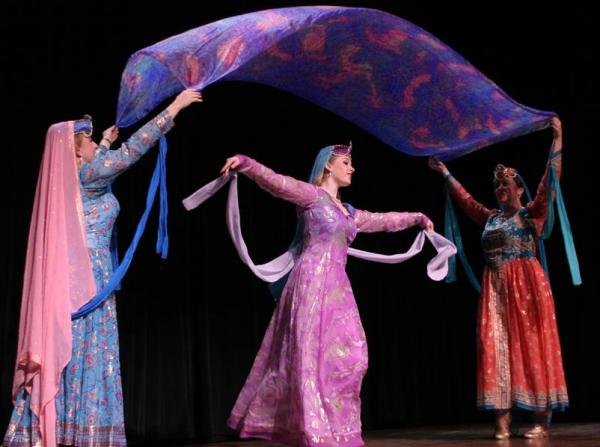
[slideshow_deploy id=’5086′]
Persian dance in spite of its remarkable history has become a less known form of dancing from the Middle East, perhaps because of the present political situation in the countries of Iran, Afghanistan and Tajikistan where it originates from. Where it is known, it is confused with and compared to Arabic dance, which is popular in other parts of the Middle East. However, Persian dance is its own distinct dance form tied to ancient mythology and contemporary histories.
Persian dance lacks the hip movements that are central to Arabic dance. Using subtle upper body motions along with hand motions, trunk undulations and facial expressions, the practitioners of this art form celebrate social events that are integral to the cultural histories of the people in these countries. It is performed at informal gatherings or weddings, where family members and friends stand in a circle, and a couple dance in the middle. Sometimes a drummer accompanies the dancers. It is generally performed by two people: and the female partner leads the way with her upper body and delicate hand movement while the male partner complements her movements. It is also common to see same-sex couples (mostly men) perform this style of dance, where either one of them leads and the other responds.
Persian dance is considered a ‘feminine’ form because of its subtle movements, but it is performed by both men and women. Historically, the dance is thought to have originated from the worship of Mithra, and has become interesting to academics studying this cult. Mithraism, which spread around parts of the Roman empire, revolves around the ancient Persian sun and light God, Mithra. The most important ritual in this cult has been the worship of Mithra through the sacrifice of a bull. The land and the people would be baptized in the blood of this bull, after which men would perform a ritualistic dance. This is thought to be one of earliest known forms of Iranian dance, and the form that probably gave birth to the Dance Persique Sacre or the sacred dance of Persia.
Over time, these have inspired contemporary dance forms and I would like to introduce you to two major local dances from Iran in which women play leading roles:
Kurdish dancing
Kurdish dances reflect samples of Kurdish life over the past thousands of years. Rhythmic and elegant movements (originating from historical record, geographical location, the Kurdish way of living, beliefs, work and struggle, war and quarrel), are called Halparke. This dance shows unity and freedom of this ethnic group and it is among the only dances involving women and men together in an outdoor area, which are still performed freely in this region. This dance can also be performed solely by women wearing very colorful local costumes with no hijab.
Gilaki dancing (Ghsemabadi):
Ghasemabadi is the name of a traditional dance displaying work on a rice field. It is a rice-harvesting dance of the Gilaki people from the Gilan province of Iran near the Caspian Sea. It is a festival of color and an aura for harvest season.
All the performers are women in this dance because all the rice field farmes of women. In this dance, women show the process of harvesting the rice by local music.
After the Islamic revolution of 1979, the National Ballet Company of Iran was banned and several dance forms including informal dances and folk dances were recast as ‘great sins’: perverse, immoral and corrupting. As expected, women are most restricted by these changes, and have been banned from performing for an audience. However, no revolution can put an end to dance entirely, particularly not when it is woven into everyday life. In spite of the ban, it is still a part of private gatherings and a part of the cultural identity of the people in these countries.
Pic Source:
Persian Dance, Kurdish Dancing: Silk Road Dance Company
Nowroz Celebrations in Northern Iraq: Daniel Nelson (via Flickr)
Gilaki Dancing: Iranian Folk Music Blog